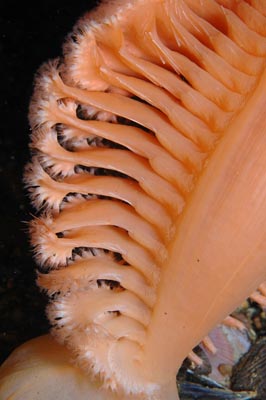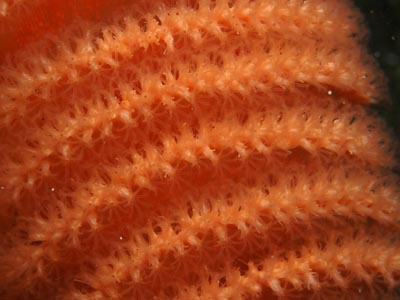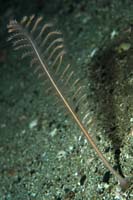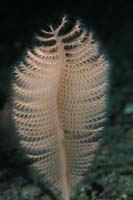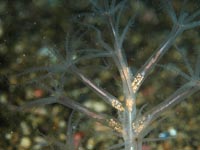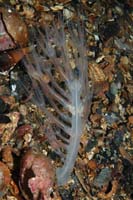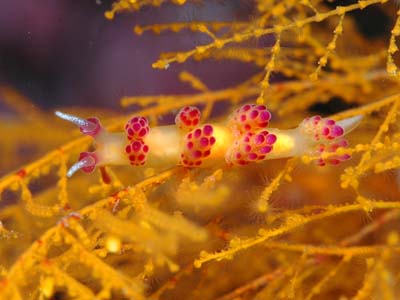Preservation Inlet, Fiordland 2007
![]() Low light levels
are something you get used to whilst diving in Fiordland. This year, things
seemed to be particularly gloomy and on this dive at Trevaccoon Head,
Long Sound, late in the afternoon, it was very, very dark.
Low light levels
are something you get used to whilst diving in Fiordland. This year, things
seemed to be particularly gloomy and on this dive at Trevaccoon Head,
Long Sound, late in the afternoon, it was very, very dark.
Below 20 metres it got black and spooky. Not far from Trevaccoon Head,
the bottom drops to over 300 metres but there was little temptation to
drop down the sheer walls into the black stuff.
These are challenging condtions for wide angle photography because natural
light usually provides an interesting and colourful backdrop. The starfish
photo was taken in shallow water, about 10 metres deep, and with a single
strobe. In order to get some background ambient light, I lowered my shutter
speed to 1/2 sec. The yellowish background light rather than the more
normal Fiordland green may indicate that the fresh water layer floating
above the sea water was particularly heavily stained with tanin from the
forest.

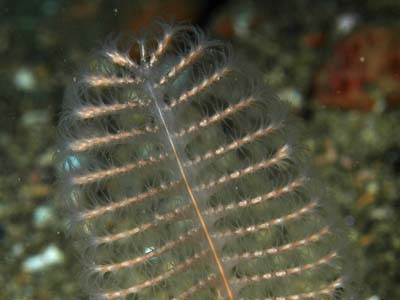
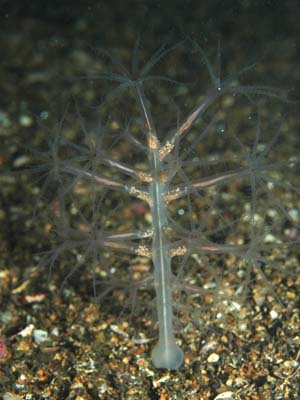
![]()
![]()
![]() Another variation
on the sea pen theme is these "branched
sea pens" (Kophobelemnon sp.) which we found
at 12 to 15 metres depth in the narrows at the mouth of Long Sound. They
may be better described as a soft coral but they certainly have some similarity
to the other sea pens.
Another variation
on the sea pen theme is these "branched
sea pens" (Kophobelemnon sp.) which we found
at 12 to 15 metres depth in the narrows at the mouth of Long Sound. They
may be better described as a soft coral but they certainly have some similarity
to the other sea pens.
I am unaware of any specific name for them but they would appear to be a Doto species. They may be a new record for Fiordland or New Zealand or the planet although this this would seem odd given that they are abundant, at least in places.
At about 6mm long, they're small and about the same size as the famous yellow Doto.



Although they're reasonably common, nobody else seems to bother taking photos of these beautiful wee things.
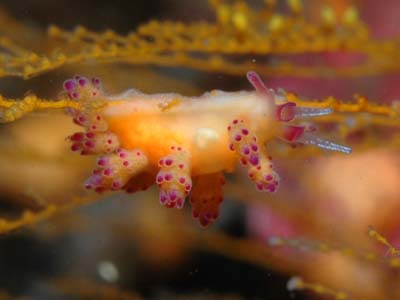
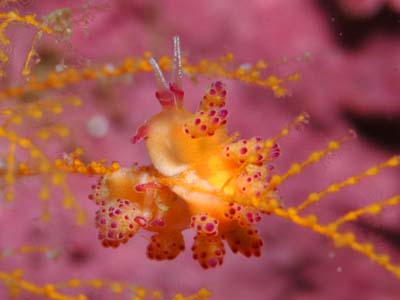
I've found these Flabellina albomarginata slugs at the Poor Knights on many occasions but never in Fiordland and I suspect this may be a new record for the species in Fiordland.


A Jason mirabilis slug is positioned on the branch of a Solanderia hydroid on which they normally feed.
In the bottom right hand corner of the photo is a second species of nudibranch, the tiny yellow Doto.
This beautifully illustrates the difference in size between larger and smaller species of nudibranch. Jasons are commonly recognised by divers but the tiny slug species are very much overlooked.

Although they're a common species around the NZ coast, Fiordland is the only place I've ever seen them whilst diving.
![]() Beautiful red coral (Errina novaezelandia) hand at Cavern Head,
Preservation Inlet.
Beautiful red coral (Errina novaezelandia) hand at Cavern Head,
Preservation Inlet.
Shot in gloomy late afternoon light (grey and raining topside) with a
20mm lens and 1/2 second shutter speed.
Here it is, happily anchored to a discarded beer bottle.
Can't have been us, we drink from cans!


![]() Sandpiper at Puysegur Landing
Sandpiper at Puysegur Landing

We
enjoyed a beautiful, calm, sunny morning on our last full day of the trip.
At the end of morning dive, from just under the flat calm surface, I looked
up and could see a 180 degree panorama of sun lit trees, forest, mountains
and blue sky.
In the afternoon we walked to the Puysegur Point light. The day remained
sunny but it blew hard as it does so often in this place of notoriously
wild weather.
![]() Pete
S, Shaun C, Matthew D, Ian S (L to R)
Pete
S, Shaun C, Matthew D, Ian S (L to R)

